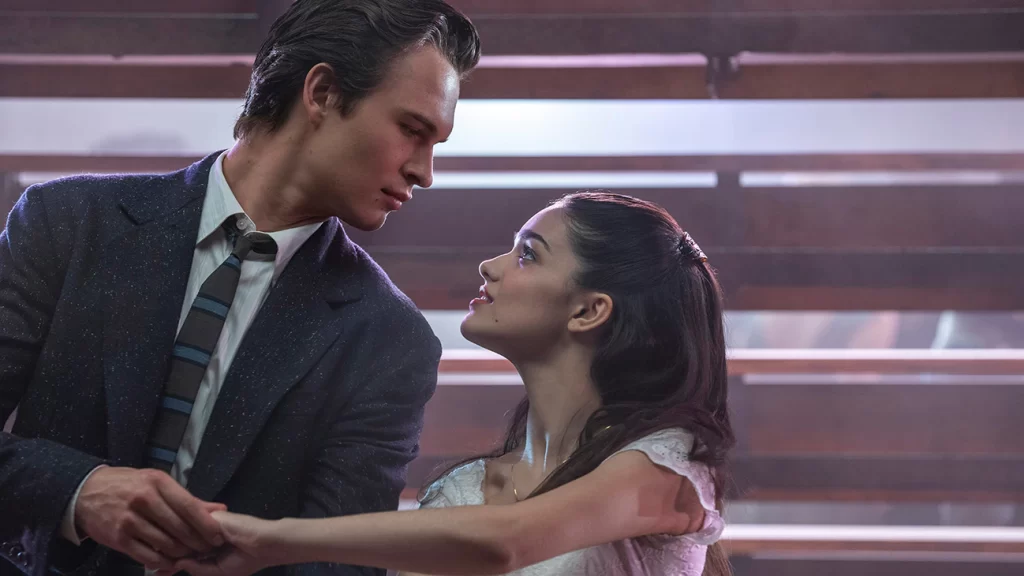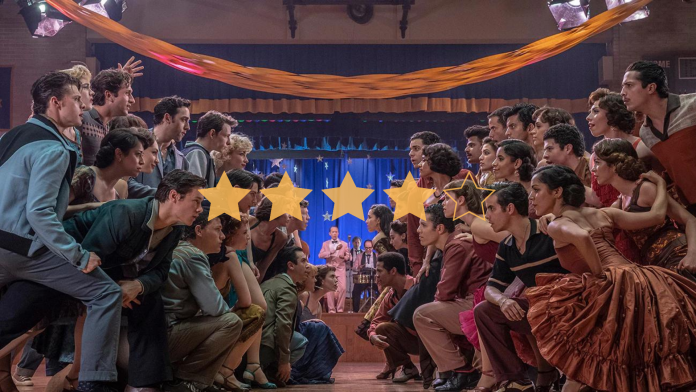In his adaptation of the classic 1957 musical, Spielberg has added renewed colour, life, and visual splendour, with an ensemble that hits every mark perfectly.
★★★★✰
First adapted for the screen in 1961 to worldwide acclaim, making a new version of West Side Story 60 years later is no easy feat. However, living legend Steven Spielberg takes to the challenge with a gusto only he could provide.
The film opens with Leonard Bernstein’s classic overture, as we see a tracking shot take us through the slum clearance in this New York neighbourhood. It’s here that we are introduced to the Jets, a gang of young rogues who wander the streets clicking, whistling, and dancing their way through their territory. In their introduction, however, we get a sense that Spielberg’s vision of West Side Story is already grittier than Robbins and Wise’s 1961 outing. For one, these boys sit as gang members a lot more believably, a rough edge present in the way they carry themselves. They still burst into ballet in the street, but there is such a physicality to everything they do that it feels like a natural expression of the rage their body just can’t contain. This is solidified when they meet the Sharks, the local Puerto Rican gang, at the end of the opening number. It’s not a dance fight they partake in, but a real, brawling fist fight. Rough and ready, there is blood spilled—and even a nail shoved through one kid’s ear. And so this violent, crumbling West Side is the ‘fair Verona’ in which we lay our scene, allowing for this contemporary retelling of Romeo and Juliet to take the stage.
As an adaptation of this classic story, one crucial element is that the central conflict should feel futile. When factors of race and class are brought into the rivalry, it threatens to slide into something more sinister. However, with a strong sense of location, and particularly the aforementioned slum clearance, Spielberg reminds the audience that this is a turf war over territory that will be nothing more than rubble in a few short weeks. He and screenwriter Tony Kushner also seek to improve the racist bones of the original by providing a more authentic portrayal of Puerto Rican people. From the fluid integration of Spanish, references to the criminalisation of pro-independence imagery, to a rendition of the liberation chant ‘La Borinqueña’, the Latin roots feel more lived in, even if the source material remains problematic. The other significant change is the character of Doc, who in this version is instead Doc’s Puerto Rican widow Valentina (Rita Moreno). This shift changes both how we see the character of Tony (Ansel Elgort), given that she is his primary mentor and offers hope for the relationship between him and Maria (Rachel Zegler). As Moreno gently sings the second act ballad ‘Somewhere’, there is a yearning for a unity between the Jets and Sharks that she has already managed to see in her own life, completely altering the song’s meaning.
Other than these changes, West Side Story remains largely similar to its previous iteration, even incorporating some of Robbin’s original choreography. However, it never feels stale: the vibrancy of the costume design, the grand nature of the production design, and Janusz Kaminski’s dynamic artistry as cinematographer combine to retain a level of visual splendour that is thoroughly engaging. The latter, especially, is made even more impressive by some extraordinary blocking and framing throughout. Songs such as ‘Cool’ and ‘America’ take to the streets, expanding them into spectacles.

Another aspect that energises this adaptation is its stellar cast. Spielberg utilises the selling power of his name, having curated an ensemble made up of Hollywood no-names who are Broadway aficionados. Supporting actors Mike Faist (Riff), Ariana DeBose (Anita), and David Alvarez (Bernardo), deftly transfer their talent from the stage to the screen, all three emanating a frustration at their situation while creating deeply human, lovable, characters beneath the anger. In particular, Anita’s heartbreak and rage culminate in DeBose’s outstandingly good rendition of ‘A Boy Like That’, in which she blows up at Maria, having found Tony leaving her bedroom.
However, the most impressive performance isn’t revealed until the credits read ‘Introducing Rachel Zegler’, as we realise that our Maria has somehow never had a professional credit before this. Zegler is pure grace and elegance: she radiates the purity necessary for the character but never falls into playing it as naivety. She understands deeply, as does Kushner through his screenplay, that Maria is a character defined by her curiosity, both culturally and sexually – she wants to explore what this new world has to offer her. The choice to have Maria kiss Tony first adds to this reading of the character. It is unfortunate then, that whilst she is able to radiate the lust necessary for any Romeo and Juliet adaptation, Ansel Elgort doesn’t know how to reciprocate it. They lack the chemistry needed to keep us rooting for them throughout. His character seems less like the charismatic ex-gang leader Tony should be, and more akin to his protagonist from Baby Driver.
That being said, what Elgort lacks in his acting skills, he makes up for vocally, with a rounded tone straight out of classic Hollywood. In fact, this whole cast miraculously makes Bernstein and Sondheim’s intricate songs sound like easy fare. There is an energy in this whole score, played by the New York Philharmonic conducted by David Newman, which is consistently matched by this ensemble.
Ultimately, it’s this energy and vibrancy that revive this classic musical for a brand-new generation in a way that works.
The Verdict
While the original text contains the problems it always has, Spielberg balances classic Hollywood glamour with contemporary stylings to dazzling effect. This adaptation injects a new lease of life, revitalised particularly by a remarkable ensemble who give it their all. It’s a visual treat, a heartfelt romp, and a true epic.
Words by Rehana Nurmahi
Support The Indiependent
We’re trying to raise £200 a month to help cover our operational costs. This includes our ‘Writer of the Month’ awards, where we recognise the amazing work produced by our contributor team. If you’ve enjoyed reading our site, we’d really appreciate it if you could donate to The Indiependent. Whether you can give £1 or £10, you’d be making a huge difference to our small team.
